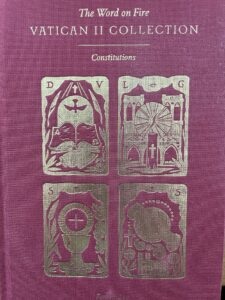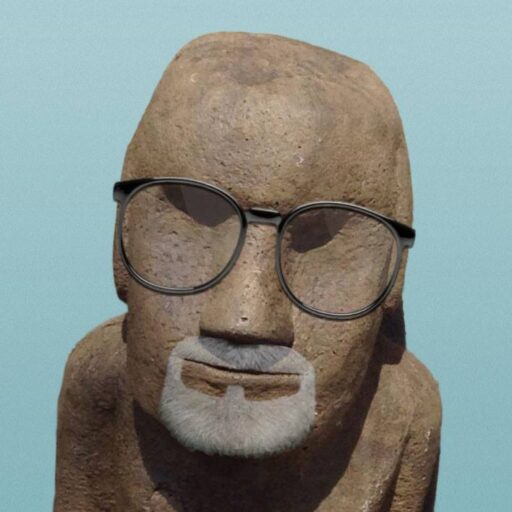 BOOK REVIEW
BOOK REVIEW
The Word on Fire Vatican II Collection: Constitutions
Forward by Bishop Robert Barron, with commentary by postconciliar popes.
I must say this is one of the most depressing books I have ever read.
First a few words about the physical book. It’s beautifully put together, with high-quality paper, binding, and cover. However, the formatting employs a technique that was quite the rage several years back and which I thoroughly hate: interspersed throughout the Council’s documents are reflections, often lengthy, relevant to given passages of text, authored by Bishop Barron and the postconciliar popes, St. John Paul II, Benedict XVI, and Francis. These continual interruptions make it extremely difficult to get into the flow of the documents, which are hard enough to follow as it is. Furthermore, the reflections themselves don’t add a whole lot: Francis’s ideas are predictably vague; St. John Paul II and Benedict’s predictably complex, sometimes to the point of inscrutability; and Bishop Barron’s predictably engaging yet often seeming put there more to fill space than to provide illumination. Better would have been to handle these reflections as footnotes displayed at the end of the book. At least that way one could plow through the constitutions without endlessly sliding off the track and laboring to get back in the groove.
Here’s what the formatting looks like:

But now to the constitutions themselves. Bishop Barron selected the four most important:
- Dei Verbum, Dogmatic Constitution on Divine Revelation
- Lumen Gentium, Dogmatic Constitution on the Church
- Sancrosanctum Concilium, Constitution of the Sacred Liturgy
- Gaudium et Spes, Pastoral Constitution on the Church in the Modern World
Dei Verbum is laudable in its brevity, and talks a lot about the importance of Sacred Scripture to the life of the Church and among the faithful. Everything here is theologically solid (as one would expect) and helpful to non-theologians seeking a better understanding of the Bible and how to interpret it. I’m not sure there is anything particularly groundbreaking here, but Dei Verbum did pave the way for beefing up Mass readings and getting the laity interested in reading the Bible – very good things indeed.
Lumen Gentium, also brief, is all about the nature of the Church: its purpose, its components, and the relationship among those components. Perhaps the most important new ground covered here is the emphasis on the laity’s responsibilities and rights as members of the Church. Apparently prior to Vatican II the laity was mainly in “pray, pay, and obey” mode; my experience over the last 20+ years is a laity where many are actively engaged in good works making a real difference inside the parish and out. If Lumen Gentium got that ball rolling, thanks be to God.
Sacrosanctum Consilium deals with the liturgy, especially the liturgy of the Mass. The guiding idea here is to get the laity more actively involved, participating and understanding what is going on. This is a great focus and a worthy goal; however, as things have played out, not only has the goal not been reached, but we may be in worse shape now than we were in 1965 when this was published. Belief in the Real Presence has gone done, and way down. Mass attendance has plummeted. Many Mass attendees don’t seem to be engaged at all. Liturgical changes that grew out of this document, such as music, method of distributing the Eucharist, simplifying and shortening the prayers, positioning the priest facing the congregation, have served to diminish rather than increase a sense of reverence. It’s a real shame: over and over it seems that the implementation of worthy Vatican II ideas was utterly botched.
Gaudium et Spes is for me inspiring in places and an absolute train wreck in others. To begin with, the document is, as Bishop Barron tells us, “the longest document ever published in the history of the Church’s ecumenical councils.” The length is not surprising when one considers the scope of what the Council is trying to address. The document takes on the entirety of secular civilization — government, politics, economics, social policy, culture, war, morality, religious freedom, technology – and attempts to describe how each component should look be brought into conformity with the divine principles of the Catholic Church as revealed to us by Jesus Christ. The task is immense, and there are some successes, to be sure, In particular, the chapters that emphasize the supreme importance of family, the infinite value of human life, and the intrinsic evil of abortion and other acts of taking innocent life, have become even more crucial today than in 1965. This document seems to have set the stage for the theology of the body that was so well developed by St. John Paul II and others, a theology that has been mocked, ignored, and shouted down — but never refuted. Great job on that one. But it is when the Council dives into politics that things go haywire. The Council seems to be 100 percent behind more active government intervention:
“The complex circumstances of our day make it necessary for public authority to intervene more often in social, economic, and cultural matters in order to bring about favorable conditions which will give more effective help to citizens and groups in their free support of man’s total well-being.”
But why is it “necessary?” Could it not be argued that is necessary for public authority to intervene less, in order to bring about these favorable conditions? I would think that argument much more consistent with the entire thrust of Catholic social teachings, which have as part of their foundation the extremely important principle of subsidiarity, the idea that decisions should be made at the most local level. But the Council moves much further away from the principle of subsidiarity in its advocacy of globalism:
“In view of the increasingly close ties of mutual dependence today between al the inhabitants and peoples of the earth, the apt pursuit and efficacious attainment of the universal common god now require of the community of nations that it organize itself in a manner suited to its present responsibilities, especially toward the many parts of the world which are still suffering from unbearable want.”
This idea is hammered at again and again. But how is concentrating power in the hands of a global few consistent with subsidiarity? Is globalism really the only way to address the admittedly complex problems of a rapidly changing and technologically evolving civilization? The underlying problem with the document’s presentation is its reluctance — almost an inability — to grapple with the problem of moral evil. Sure, globalism is great if global leaders are driven by Catholic moral principles — but what makes anyone think such an outcome is likely given the entire recorded history of man? The Council doesn’t really explain how such a glorious government could come to pass, it just assumes that it might because humanity is evolving toward a clearer understanding of right and wrong. The Council states in its closing document that its intention throughout was to take a conciliatory and inclusive approach:
“But one must realize that this council, which exposed itself to human judgment, insisted very much more upon this pleasant side of man, rather than on his unpleasant one. Its attitude was very much and deliberately optimistic. A wave of affection and admiration flowed from the council over the modern world of humanity. Errors were condemned, indeed, because charity demanded this no less than did truth, but for the persons themselves there was only warning, respect, and love. Instead of depressing diagnoses, encouraging remedies; instead of direful prognostics. messages of trust issued from the council to the present-day world. The modern world’s values were not only respected but honored, its efforts approved, its aspirations purified and blessed.”
Well, it may be that you attract more bees with honey than vinegar, but you attract more souls to Christ with honey and vinegar. It’s the hope of eternal life and fear of eternal damnation that inspires people to live a life of faith. The crucial question, what will happen to my eternal soul, is ultimately what draws someone to Christ because there and only there can the answer be found. Vatican II tries too hard to argue for God on the world’s terms, on the world’s turf. The Council strives to make its arguments and exhortations sound pleasant, but to do so, by the council’s own admission, necessitates glossing over evil (the “unpleasant” side of man). Study the great evangelists. They hammer away at the glory of God and the horror of hell. God is real. Satan is real. This message, while stated with emphasis on occasion throughout these documents, just doesn’t come across in Gaudium et Spes; instead, it reads like a report of recommendations from a board of directors.
Sadly, it seems to me, the moral tone of dwelling on the pleasant has taken a firm grip on the Church hierarchy. Seldom does one hear a homily on unpleasant topics such as hell or sexual sins (or sin in general). Far from being inspired to a deeper faith and bolder secular role, the faithful have silently headed for the exits. And far from gaining respect for and being influenced by an inclusive and conciliatory Church, society (in the West, at least) has rushed to embraced evils ever more boldly as the Church has become easier to ignore and easier for governments to manage and control.
I’m sure this is not what the leaders of Vatican II had in mind. These were some of the most intelligent, faith-filled, and orthodox men on the planet. But because evil was given short shrift, the devil, always the opportunist, was emboldened after Vatican II, running wild in secular society and even in the Church itself.
One area where Vatican II has proven successful is in the realm of pro-life morality and politics. Here it is the media, not the Church, glossing over the magnitude of the movement. Why are so many inspired to fight boldly for innocent life? Part of the reason is surely that in Vatican II the foundation of that call was based on struggle between good and evil; here, the Council took a clearly confrontational rather than conciliatory stance — a stance confrontational to sin but not to the sinner, it must be emphasized. This stance is possible because it is rooted in the moral certainty of the infinite value of human life, whereas in much of Gaudium et Spes the outlook has roots in debatable political theories and incomplete appreciation of human nature. The pro-life movement is an outcome of Vatican II we can use to move forward and bring the light of Christ to our troubled world.

Great reflection on the book and its authors. And you pulled no punches. Thanks.
Bill
Thanks! Maybe pulling punches is worse for the puncher than the punchee. Or equally bad for both.